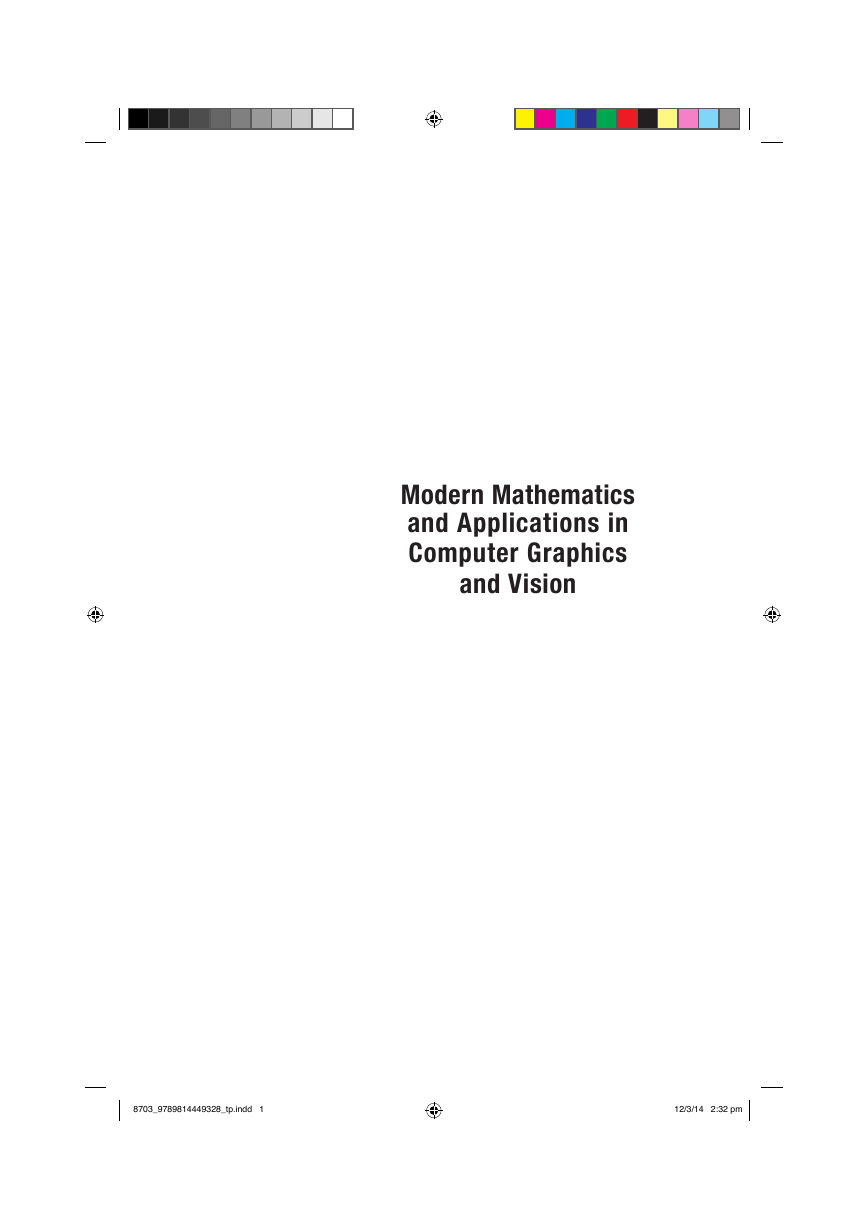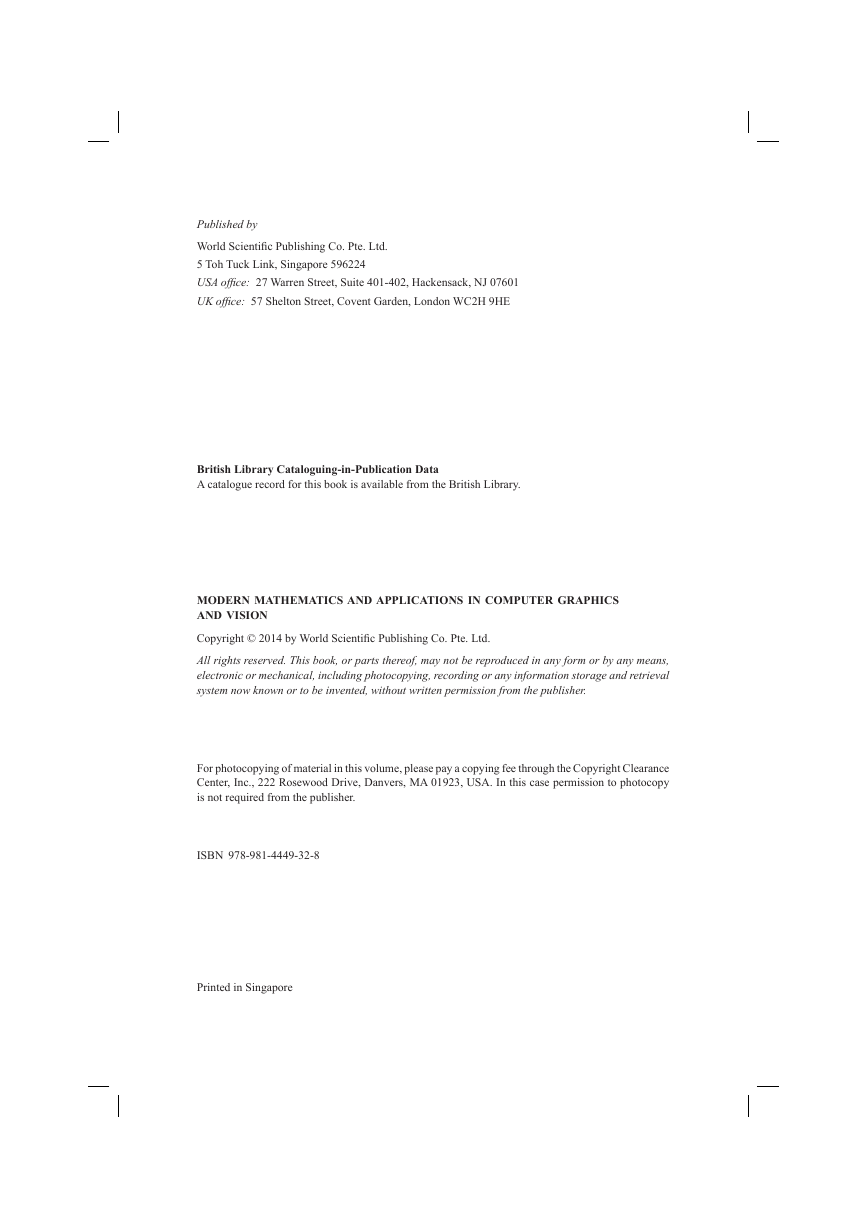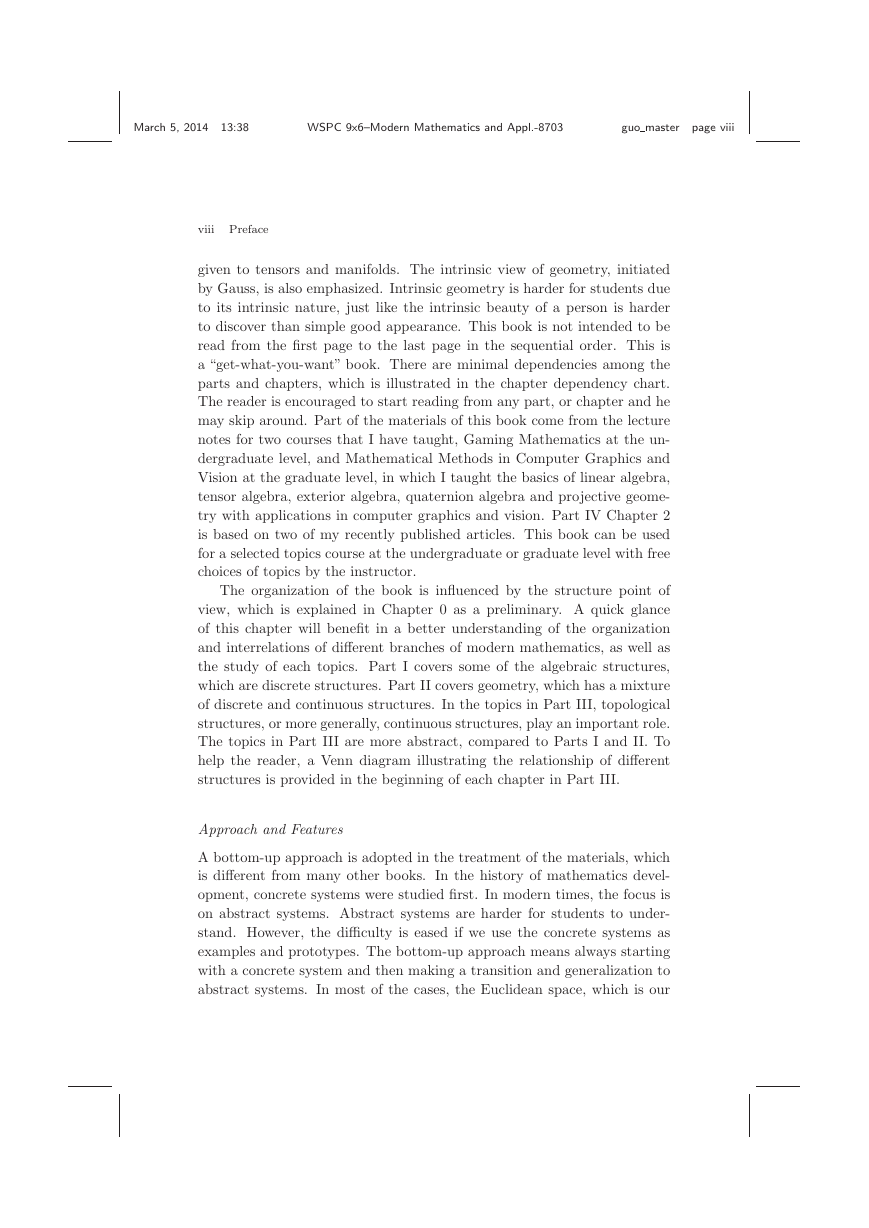Modern Mathematics
and Applications in
Computer Graphics
and Vision
8703_9789814449328_tp.indd 1
12/3/14 2:32 pm
�
May 2, 2013
14:6
BC: 8831 - Probability and Statistical Theory
PST˙ws
This page intentionally left blank
This page intentionally left blank
�
Modern Mathematics
and Applications in
Computer Graphics
and Vision
Hongyu Guo
University of Houston — Victoria, USA
N E W J E R S E Y • L O N D O N • S I N G A P O R E • B E I J I N G • S H A N G H A I • H O N G K O N G • TA I P E I • C H E N N A I
World Scientific
8703_9789814449328_tp.indd 2
12/3/14 2:32 pm
�
Published by
World Scientific Publishing Co. Pte. Ltd.
5 Toh Tuck Link, Singapore 596224
USA office: 27 Warren Street, Suite 401-402, Hackensack, NJ 07601
UK office: 57 Shelton Street, Covent Garden, London WC2H 9HE
British Library Cataloguing-in-Publication Data
A catalogue record for this book is available from the British Library.
MODERN MATHEMATICS AND APPLICATIONS IN COMPUTER GRAPHICS
AND VISION
Copyright © 2014 by World Scientific Publishing Co. Pte. Ltd.
All rights reserved. This book, or parts thereof, may not be reproduced in any form or by any means,
electronic or mechanical, including photocopying, recording or any information storage and retrieval
system now known or to be invented, without written permission from the publisher.
For photocopying of material in this volume, please pay a copying fee through the Copyright Clearance
Center, Inc., 222 Rosewood Drive, Danvers, MA 01923, USA. In this case permission to photocopy
is not required from the publisher.
ISBN 978-981-4449-32-8
Printed in Singapore
�
March 5, 2014
13:38
WSPC 9x6–Modern Mathematics and Appl.-8703
guo master page v
To Yanping and Alicia
v
�
May 2, 2013
14:6
BC: 8831 - Probability and Statistical Theory
PST˙ws
This page intentionally left blank
This page intentionally left blank
�
March 5, 2014
13:38
WSPC 9x6–Modern Mathematics and Appl.-8703
guo master page vii
Preface
While I am teaching computer graphics, computer vision and game pro-
gramming courses, too often I encounter students in classes, who have a
great interest and ambition in these fields but only to feel limited by the
lacking of proper mathematics preparation. This is because, unlike other
areas of computer science, where discrete mathematics is mostly applied,
computer graphics and vision, as well as game programming utilize many
areas of continuous mathematics. For example, ray tracing in computer
graphics rendering is purely the computational simulation of the optical
process using laws in physics. The regular university curriculum does not
provide proper preparation of the continuous mathematics for these stu-
dents. Researchers and professionals in these areas have their struggles
too. Unlike the students, they do not have a problem with multiplying two
matrices. However, more and more modern arsenal of abstract mathemat-
ics is utilized in research literature, for example, the concepts of tensors
and differentiable manifolds. This book is intended to help them in these
areas to better understand and apply the concepts and theories needed in
their study and research.
Intended Audience
The intended audience is upper level undergraduate students, graduate stu-
dents and researchers in computer graphics and vision and related areas. If
you are a believer of the saying “A mathematician is a blind man in a dark
room looking for a black cat which is not there”, probably this book is not
for you. You should consider returning the book and getting a refund. If
you have been looking for a book with a concise account of a certain topic
but only was frustrated because the books for mathematics majors have
too many details than you needed, I hope this is the book you have been
looking for.
Students and researchers in physics and engineering share most of the
arsenal of mathematics with the computer graphics and vision community
and therefore this book should help them as well. If you are a math major
and want to take a break from math for a moment, you can read this book.
Organization
The book is organized in four parts, Part I Algebra, Part II Geometry, Part
III Topology and More, and Part IV Applications. Particular emphasis was
vii
�
March 5, 2014
13:38
WSPC 9x6–Modern Mathematics and Appl.-8703
guo master page viii
viii Preface
given to tensors and manifolds. The intrinsic view of geometry, initiated
by Gauss, is also emphasized. Intrinsic geometry is harder for students due
to its intrinsic nature, just like the intrinsic beauty of a person is harder
to discover than simple good appearance. This book is not intended to be
read from the first page to the last page in the sequential order. This is
a “get-what-you-want” book. There are minimal dependencies among the
parts and chapters, which is illustrated in the chapter dependency chart.
The reader is encouraged to start reading from any part, or chapter and he
may skip around. Part of the materials of this book come from the lecture
notes for two courses that I have taught, Gaming Mathematics at the un-
dergraduate level, and Mathematical Methods in Computer Graphics and
Vision at the graduate level, in which I taught the basics of linear algebra,
tensor algebra, exterior algebra, quaternion algebra and projective geome-
try with applications in computer graphics and vision. Part IV Chapter 2
is based on two of my recently published articles. This book can be used
for a selected topics course at the undergraduate or graduate level with free
choices of topics by the instructor.
The organization of the book is influenced by the structure point of
view, which is explained in Chapter 0 as a preliminary. A quick glance
of this chapter will benefit in a better understanding of the organization
and interrelations of different branches of modern mathematics, as well as
the study of each topics. Part I covers some of the algebraic structures,
which are discrete structures. Part II covers geometry, which has a mixture
of discrete and continuous structures. In the topics in Part III, topological
structures, or more generally, continuous structures, play an important role.
The topics in Part III are more abstract, compared to Parts I and II. To
help the reader, a Venn diagram illustrating the relationship of different
structures is provided in the beginning of each chapter in Part III.
Approach and Features
A bottom-up approach is adopted in the treatment of the materials, which
is different from many other books. In the history of mathematics devel-
opment, concrete systems were studied first. In modern times, the focus is
on abstract systems. Abstract systems are harder for students to under-
stand. However, the difficulty is eased if we use the concrete systems as
examples and prototypes. The bottom-up approach means always starting
with a concrete system and then making a transition and generalization to
abstract systems. In most of the cases, the Euclidean space, which is our
�
















 2023年江西萍乡中考道德与法治真题及答案.doc
2023年江西萍乡中考道德与法治真题及答案.doc 2012年重庆南川中考生物真题及答案.doc
2012年重庆南川中考生物真题及答案.doc 2013年江西师范大学地理学综合及文艺理论基础考研真题.doc
2013年江西师范大学地理学综合及文艺理论基础考研真题.doc 2020年四川甘孜小升初语文真题及答案I卷.doc
2020年四川甘孜小升初语文真题及答案I卷.doc 2020年注册岩土工程师专业基础考试真题及答案.doc
2020年注册岩土工程师专业基础考试真题及答案.doc 2023-2024学年福建省厦门市九年级上学期数学月考试题及答案.doc
2023-2024学年福建省厦门市九年级上学期数学月考试题及答案.doc 2021-2022学年辽宁省沈阳市大东区九年级上学期语文期末试题及答案.doc
2021-2022学年辽宁省沈阳市大东区九年级上学期语文期末试题及答案.doc 2022-2023学年北京东城区初三第一学期物理期末试卷及答案.doc
2022-2023学年北京东城区初三第一学期物理期末试卷及答案.doc 2018上半年江西教师资格初中地理学科知识与教学能力真题及答案.doc
2018上半年江西教师资格初中地理学科知识与教学能力真题及答案.doc 2012年河北国家公务员申论考试真题及答案-省级.doc
2012年河北国家公务员申论考试真题及答案-省级.doc 2020-2021学年江苏省扬州市江都区邵樊片九年级上学期数学第一次质量检测试题及答案.doc
2020-2021学年江苏省扬州市江都区邵樊片九年级上学期数学第一次质量检测试题及答案.doc 2022下半年黑龙江教师资格证中学综合素质真题及答案.doc
2022下半年黑龙江教师资格证中学综合素质真题及答案.doc